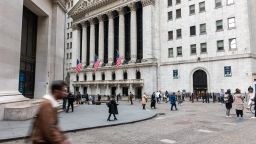US consumers could be reaching their breaking point. After dealing with elevated inflation and the highest interest rates in decades, they’re starting to rein in their spending.
Last month, retail sales were unchanged from March, when spending increased by a downwardly revised 0.6%, the Commerce Department reported on Wednesday.
April spending missed the 0.4% increase that economists had projected, according to FactSet. The figures are adjusted for seasonal swings but not inflation.
By comparison, a year ago, retail sales surged by 3%.
Stripping away auto sales, April retail sales were up by 0.2% last month, matching economists’ expectations.
By sector, the biggest monthly increase in spending was at gas stations, where sales were up 3.1% in April compared to March. That’s likely a result of surging gas prices experienced in the previous two months. However, they’ve started to cool in recent weeks.
Spending was also higher at clothing and accessory stores (+1.6%), food and beverage stores (+0.8%) as well as at restaurants and bars (+0.2%).
Almost all other sectors saw monthly declines in spending. The biggest decline was online retail sales, which fell by 1.2% last month. That’s a significant development given online sales have been a bright spot in prior months.
Separately, new inflation figures released Wednesday by the Bureau of Labor Statistics showed some improvement. The nation’s annual inflation rate eased from 3.5% in March to 3.4% in April, in line with expectations. That came after March’s unexpected jump in inflation.
Both pieces of data are welcome news for Federal Reserve officials: Central bankers have been looking for signs that inflation will return back to the Fed’s 2% target.
Financially stressed consumers are ushering in an economic slowdown
Wednesday’s retail report is another piece of evidence that the economy is slowing. That’s good in the sense that it doesn’t give retailers the ability to pass along higher prices to consumers if they aren’t willing to accept them, which had previously been the case.
“But if that transitions into a deeper slowdown it could herald some economic problems that markets would not welcome,” Seema Shah, chief global strategist at Principal Asset Management, said in a note on Wednesday. For the time being though, she said the retail sales report gives the Fed more of a reason to ponder cutting interest rates at upcoming meetings.
Many economists now feel that the Fed could cut interest rates as soon as September.
The much weaker-than-expected retail sales data comes as the nation’s unemployment rate ticked up last month to 3.9% as the pace of hiring slowed. Also, the number of people applying for first-time unemployment benefits recently rose to the highest level since August.
The weakening labor market is causing consumers to act with “more prudence,” EY senior economist Lydia Boussour said in a note Wednesday.
Consumers are also taking on a lot more debt to support their spending but increasingly aren’t making payments on time, according to data released earlier this week by the New York Fed. Notably, the percentage of credit card balances in serious delinquency (90 days or more late) climbed to its highest level since 2012.






